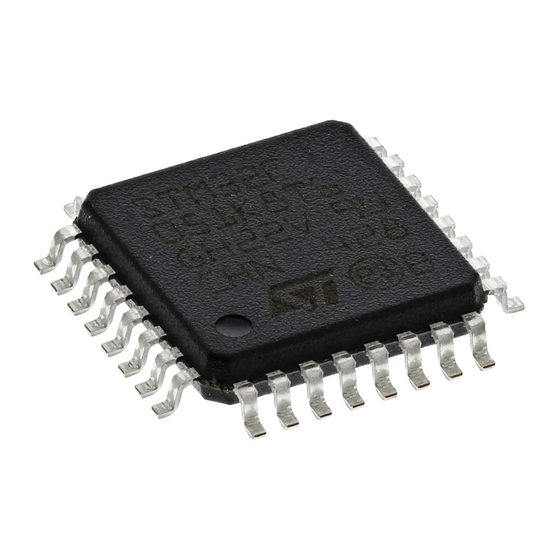
STMicroelectronics STM32F05 series Manuals
Manuals and User Guides for STMicroelectronics STM32F05 series. We have 1 STMicroelectronics STM32F05 series manual available for free PDF download: Reference Manual
STMicroelectronics STM32F05 series Reference Manual (742 pages)
advanced ARM-based 32-bit MCUs
Brand: STMicroelectronics
|
Category: Microcontrollers
|
Size: 10 MB
Table of Contents
-
-
-
-
Introduction62
-
-
-
-
-
-
GPIO Registers127
-
-
SYSCFG Registers135
-
-
(Syscfg_Exticr1)136
-
-
-
(Syscfg_Exticr2)138
-
(Syscfg_Exticr3)138
-
(Syscfg_Exticr4)139
-
-
-
-
DMA Introduction142
-
-
DMA Transactions143
-
Arbiter144
-
DMA Channels144
-
Error Management147
-
Interrupts147
-
-
DMA Registers150
-
DMA Register Map155
-
-
-
EXTI Registers163
-
-
Introduction168
-
-
-
Data Management183
-
ADC Interrupts191
-
ADC Registers192
-
-
-
-
DAC Data Format207
-
DAC Conversion207
-
DMA Request209
-
DAC Registers209
-
-
(Dac_Dhr12R1)211
-
-
-
(Dac_Dhr12L1)211
-
-
-
(Dac_Dhr8R1)212
-
-
DAC Register Map214
-
-
COMP Registers219
-
-
-
Time-Base Unit225
-
Counter Modes227
-
Clock Sources237
-
PWM Input Mode243
-
PWM Mode245
-
One-Pulse Mode255
-
Debug Mode264
-
-
TIM1 Registers265
-
-
-
Time-Base Unit293
-
Counter Modes295
-
Clock Sources304
-
PWM Input Mode310
-
PWM Mode312
-
One-Pulse Mode315
-
Debug Mode328
-
-
-
-
Tim3_Dier)335
-
-
-
Tim3_Ccmr1)339
-
-
-
Tim3_Ccmr2)342
-
-
-
Tim3_Ccr1)346
-
Tim3_Ccr2)346
-
-
-
Tim3_Ccr3)348
-
Tim3_Ccr4)348
-
-
-
Tim3_Dmar)349
-
-
-
-
Time-Base Unit354
-
Counter Modes356
-
Clock Source359
-
PWM Mode363
-
Debug Mode364
-
-
TIM14 Registers365
-
-
-
Time-Base Unit379
-
Counter Modes380
-
Clock Sources384
-
PWM Mode391
-
One-Pulse Mode397
-
Debug Mode401
-
-
TIM15 Registers402
-
-
-
Tim17_Dier)424
-
-
-
Tim17_Egr)426
-
-
-
Tim17_Ccmr1)427
-
-
-
Tim17_Ccer)430
-
-
-
Tim17_Rcr)433
-
-
-
Tim17_Ccr1)433
-
-
-
Tim17_Bdtr)434
-
-
-
Tim17_Dmar)436
-
-
-
-
Time-Base Unit441
-
Counter Modes443
-
Clock Source446
-
Debug Mode446
-
-
TIM6 Registers447
-
-
Introduction453
-
-
Window Option453
-
Debug Mode454
-
-
IWDG Registers455
-
-
-
Debug Mode464
-
WWDG Registers465
-
-
-
Mode Selection472
-
Software Reset476
-
Data Transfer477
-
I2C Slave Mode479
-
I2C Master Mode487
-
Table 70. Table503
-
Smbus Slave Mode506
-
Error Conditions514
-
DMA Requests516
-
I 2 C Interrupts517
-
I 2 C Debug Mode519
-
I 2 C Registers519
-
I2C Register Map534
-
-
Introduction535
-
-
Tamper Detection546
-
Alarm Output548
-
RTC Interrupts549
-
RTC Registers550
-
-
(Rtc_Tafcr)565
-
-
RTC Register Map569
-
-
-
-
Transmitter577
-
Receiver579
-
Parity Control591
-
Smartcard Mode597
-
USART Interrupts609
-
USART Registers611
-
-
Introduction634
-
I²S Features635
-
-
Initialize SPI642
-
SPI Status Flags646
-
SPI Error Flags647
-
SPI Interrupts652
-
-
Clock Generator660
-
I 2 S Slave Mode664
-
I 2 S Interrupts669
-
DMA Features669
-
-
-
-
Introduction681
-
-
Reset and Clocks684
-
Max Count Error686
-
Acquisition Mode688
-
TSC Interrupts689
-
TSC Registers690
-
TSC Register Map697
-
-
-
Introduction699
-
-
HDMI-CEC Pin700
-
Bit Timing701
-
-
Arbitration702
-
Error Handling704
-
Bit Error704
-
Message Error704
-
-
-
-
-
Overview718
-
SW Debug Port721
-
SW-DP Registers723
-
SW-AP Registers725
-
Core Debug725
-
-
DBG Register Map732
-
-
Revision History
741
Advertisement
Advertisement
Related Products
- STMicroelectronics STM32F050G6
- STMicroelectronics STM32F050K4
- STMicroelectronics STM32F050G4
- STMicroelectronics STM32F050F6
- STMicroelectronics STM32F050F4
- STMicroelectronics STM32F050K6
- STMicroelectronics STM32F050C4
- STMicroelectronics STM32F050C6
- STMicroelectronics STM32F038F6
- STMicroelectronics STM32F042C6
